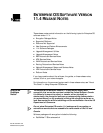
12
E
NTERPRISE
OS S
OFTWARE
V
ERSION
11.4 R
ELEASE
N
OTES
Multicast Border Router (MBR)
To allow sources and receivers inside multiple autonomous multicast routing
domains (each running a different multicast routing protocol -- DVMRP, MOSPF, or
PIM-SM) to communicate, the regions must be connected by multicast border
routers (MBRs). The primary role of the MBR is to pull down the traffic from one
domain to the another domain. This MBR functionality is implemented in the
Enterprise OS device to allow the efficient interoperation among independent
multicast routing protocols. A common forwarding cache to forward the multicast
data packets has been implemented. MBR makes it easier to have a unified
forwarding table for multicast data traffic. The multicast routing protocols will
maintain protocol specific routing states and create forwarding entries in the
unified forwarding table for multicast traffic.
IGMPv2 Enhancements
Adding to the IGMPv1 support, 11.4 will be adding support for IGMPv2 (RFC
2236). Feature enhancements include the following:
■ Allowing a host to inform a multicast router when it no longer wants to receive
traffic for a given multicast group.
■ Defines a new procedure for electing the multicast querier on a LAN; the
multicast router with the lowest IP address is always chosen as the querier.
■ Defines a new type of Query message, called the Group-Specific Query. This
type of message allows a router to transmit a query to a specific multicast
group rather than all groups that reside on a directly attached subnet.
PPP over Ethernet (PPPoE)
With 11.4, PPP over Ethernet (PPPoE) is available to offer a seamless integration of
broadband access technology into the existing infrastructure and operational
model of remote access. As specified in the informational RFC 2516, PPPoE
encapsulates PPP packets over Ethernet. It is intended for use by a host PC to
interact with a broadband modem (e.g. xDSL, cable, and wireless access devices)
to achieve access to high-speed data networks. The PPPoE offering is targeted at
Carriers, ISPs, and NSPs with an ATM backbone for use in a VPN environment for
broadband access.
Ethernet is the most proven, familiar, and cost effective LAN technology that exists
today. PPP is the most popular dial-up transport, created to define negotiating
connectivity parameters, authenticate users, dynamically assign IP addresses, and
support multiprotocol environments. In a remote dial-up environment, besides the
traditional analog and ISDN modems, there are server other high-speed,
broadband CPEs being rapidly deployed (for example, xDSL, cable, and wireless
access devices). All high-speed, broadband access equipment requires end users to
be knowledgeable in their technologies, connectivity, and configuration
characteristics. With PPPoE, much of the complexity of these broadband devices is
hidden from the user. In addition to ease of configuration and use for the end
user, PPPoE also simplifies provisioning, installation, and management for the
service provider.
Advantages of PPPoE:
■ Supports multiple hosts and users across a dedicated broadband connection
and a single ATM or Frame Relay PVC with the same Ethernet infrastructure.


















